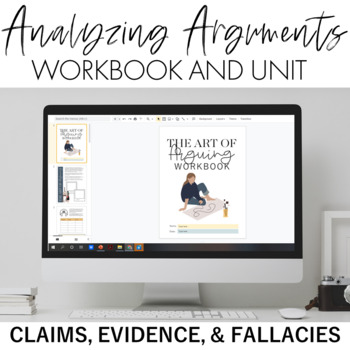Analyzing Arguments Unit - Claims, Evidence, Counterarguments, & Fallacies
- Zip
What educators are saying
Also included in
- If you are new to teaching AP Lang or your AP Lang curriculum needs an upgrade, this AP Lang Growing Curriculum Bundle is for you! I know if you’re reading this, you’re an AP Lang teacher who is looking for a curriculum that is engaging, 2020 AP Lang CED aligned, research-based, thorough, and effectPrice $100.00Original Price $124.00Save $24.00
Description
Empower your students to evaluate and create strong arguments with my Analyzing Arguments Unit!
In this 12-day unit, students will evaluate and create claims, evidence, counterarguments, and fallacies.
The Art of Arguing Workbook is a complete unit to teach students how to effectively use claims and evidence. This unit aligns to the AP English Language and Composition Conceptual Framework for Claims and Evidence, though it is appropriate for grades 9 through 12 and meets the standards for argumentation for those grades.
Each lesson in this unit includes valuable information for students to learn about reading and writing claims and assessing and using evidence. It includes editable directions, so you can modify parts of the unit to meet the needs of your students. It also comes with both print and digital options.
Activity Overview:
- The Art of Arguing: This activity will help students understand the aim of an academic argument.
- The Academic Debate: In this activity, students will understand the aim of an academic debate by listening to a podcast and completing an activity.
- The Academic Controversy: In this small group/partner activity, students will participate in an interactive Academic Controversy by arguing both sides of an argument.
- The Claim Café: In this activity, students will learn about the components of a strong versus weak claim.
- The Evidence Scavenger Hunt: Students will participate in an engaging full group activity. They’ll be out of their seats searching for evidence from their classmates, and they’ll learn about using varied, substantial evidence.
- The Evidence Balance: Using a series of task cards, students will work with a small group (or individually) to learn about relevant, credible, and sufficient evidence.
- Make the Connection: Students will practice connecting evidence to claims.
- Counter the Counterclaim: Using task cards, students will practice conceding and addressing counterclaims in a way that strengthens their own arguments.
- Get it organized: For this final activity, students will learn about organizing an argument by exploring five different arguments in a silent discussion group activity.
- Logical Fallacies: With this culminating project-based assessment, students will create visual advertisements in small groups to learn how to avoid logical fallacies.
Excerpts from texts included:
- William Banting's "Letter on Corpulence"
- Elizabeth Cady Stanton's "The Destructive Male" speech
- President Barack Obama's 2004 Democratic National Convention Keynote Speech
- US Secretary of Education Miguel Cardona's remarks at the Department of Education's Equity Summit Series
- Sojourner Truth's "Ain't I a Woman?" Speech
Please see the video preview for a closer look at the activities.
This activity is part of my AP Language and Composition Growing Bundle.





